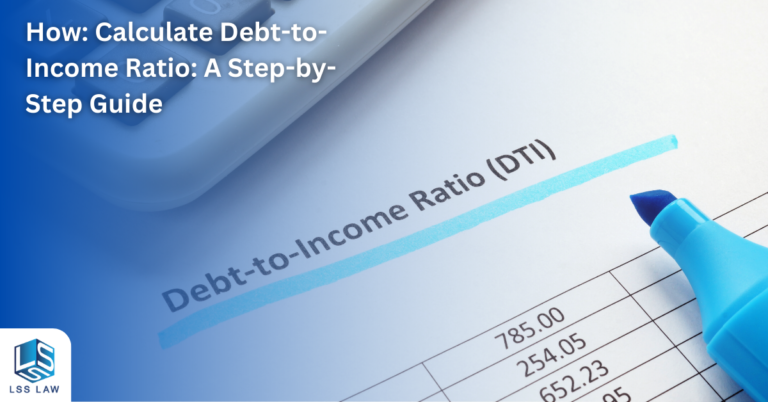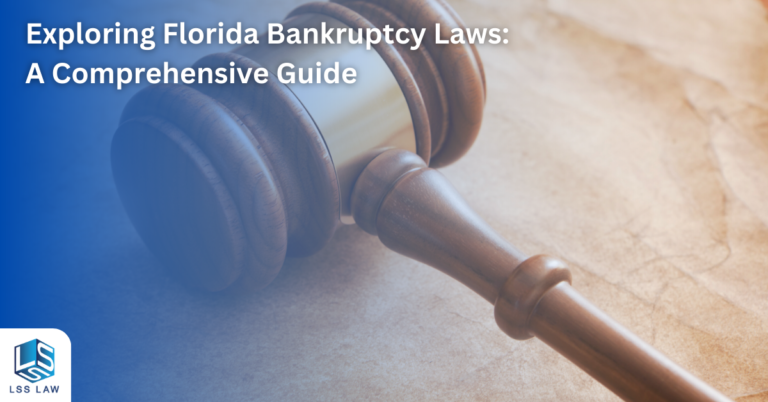Are you feeling overwhelmed by debt and unsure of how to manage it? You’re not alone. Many people in Florida struggle with debt, and understanding your financial situation is the first step towards regaining control. One essential tool that will assess your financial health is calculating your debt-to-income ratio (DTI). This guide will walk you through the process of how to calculate your debt-to-income ratio and provide insights into what it means for your financial future.
What is Debt-to-Income Ratio?

One important financial metric, known as the debt-to-income ratio (or DTI), compares monthly debt payments to gross monthly income. It’s used by lenders, creditors, and financial institutions to evaluate your ability to manage and repay debts. A lower DTI indicates that you have a healthier balance between your income and debt obligations, making you a more attractive borrower.
Debt-to-income ratios are critical in determining your overall financial health and creditworthiness. Financial institutions and lenders often use debt-to-income ratios to evaluate your ability to manage and repay debts, making it a vital metric to monitor and improve over time.
How to Calculate Your Debt-to-Income Ratio

Determining your debt-to-income ratio is a straightforward process. Follow these steps to calculate your DTI:
1. Calculate Your Monthly Income
To calculate your gross monthly income, add up all your sources of income, such as salary, wages, bonuses, and any other earnings before taxes and other deductions. If you receive income from rental properties, investments, or other sources, include those as well.
When calculating your debt-to-income ratio, use your monthly gross income. This figure represents your total income before taxes and other deductions, such as health insurance premiums and retirement contributions. By using your monthly gross income as the basis for your DTI calculation, you will get a more accurate representation of your financial situation and determine how much of your income is dedicated to debt repayment.
2. Add Up Your Monthly Debt Payments
Next, determine your total monthly debt payments. This includes credit card payments, personal loans, auto loans, mortgage payments, student loans, and other monthly debt obligations. Be sure to include minimum payments and any additional payments you make toward your debts. Including these monthly minimum debt payments in your DTI calculation helps you understand the true impact of your debt obligations on your financial health.
3. Divide Your Total Monthly Debt Payments by Your Gross Monthly Income
To calculate your debt-to-income ratio, calculate your total monthly debt payments divided by your gross monthly income. The result will be a decimal, which you can multiply by 100 to express as a percentage.
For example, if your gross monthly income is $5,000 and your total monthly debt payments are $2,000, your DTI would be calculated as follows:
$2,000 (monthly debt payments) ÷ $5,000 (gross monthly income) = 0.4
0.4 x 100 = 40%. So, in this scenario, your debt-to-income ratio is 40%.
Understanding Your Debt-to-Income Ratio
Now that you know how to calculate your debt-to-income ratio, it’s essential to understand what it means for your financial health. Generally, the lower your DTI the better. A low percentage indicates that you have more income available to manage your debts. Lenders typically consider a DTI of 36% or lower a good debt-to-income ratio, with no more than 28% of that being allocated towards housing costs (monthly mortgage payment or rent).
A higher DTI may signal that you are overextended and struggling to manage your debts, which can negatively impact your credit score and make it more challenging to obtain new credit or loans. It’s essential to monitor your debt-to-income ratio and take steps to reduce it if necessary, such as paying off high-interest debt, increasing your income, or adjusting your spending habits.
By understanding and managing your debt-to-income ratio, you can make informed decisions about your financial future and work towards achieving a healthier financial balance. If you’re struggling with debt and considering bankruptcy, consult with an experienced bankruptcy attorney to explore your options and develop a strategy for overcoming your financial challenges.
The Importance of Debt-to-Income Ratio in Bankruptcy
When considering bankruptcy as a solution to your financial struggles, your debt-to-income ratio can play a significant role in determining the best course of action. A high DTI may indicate that you are unable to manage your current debt obligations and could benefit from bankruptcy protection.
In a Chapter 7 bankruptcy, your assets may be liquidated to pay off your debts, and any remaining dischargeable debts are eliminated. A lower DTI after bankruptcy can help you rebuild your financial health and improve your credit score over time.
In a Chapter 13 bankruptcy, you’ll create a repayment plan to pay off your debts over a period of three to five years. Your DTI will be a crucial factor in determining the feasibility of your repayment plan and your eligibility for this type of bankruptcy.
Regardless of the type of bankruptcy you choose, understanding your debt-to-income ratio and working to improve it can help you regain control of your finances and move towards a brighter financial future.
How to Improve Your Debt-to-Income Ratio
If your debt-to-income ratio is higher than desired, there are several steps you can take to improve it and increase your chances of obtaining new credit or loans in the future:
- Increase your income: Look for opportunities to boost your earnings, such as taking on a part-time job, freelancing, or requesting a raise at your current job.
- Pay off high-interest debt: Focus on paying off credit card balances and other high-interest loans to reduce your monthly debt payments.
- Refinance or consolidate debts: Consider refinancing or consolidating your debts into a single loan with a lower interest rate and more manageable monthly payments.
- Live on a budget: Develop and use a budget that prioritizes debt repayment and helps you track your spending to ensure you’re living within your means.
- Avoid taking on new debt: Be cautious about opening new credit accounts or taking on additional loans, as this can further increase your DTI.
By taking these steps to improve your debt-to-income ratio, you can demonstrate responsible financial behavior, making you a more attractive borrower to lenders and helping you achieve your financial goals.
Seeking Professional Help for Debt Management
If you’re struggling with debt and are unsure of how to improve your debt-to-income ratio, seeking professional help can be a valuable resource. A bankruptcy attorney can provide guidance on your options, including whether bankruptcy is the right choice for your situation.
At LSS Law, we’re committed to helping individuals in South Florida navigate their financial challenges and work towards a brighter future. With our expertise in bankruptcy strategy and planning, we can help you understand your options and make informed decisions about your financial future. Schedule a free consultation for personal bankruptcies (Chapters 7 and 13) at our Fort Lauderdale or Miami locations, either in person or via Zoom, to discuss your unique situation and develop a personalized plan for financial success.
The Role of Debt-to-Income Ratio in Mortgage Approval
One of the most common situations where your debt-to-income ratio comes into play is when applying for a mortgage loan. Mortgage lenders typically use your DTI to determine your ability to repay the loan and manage your monthly housing costs.
Most lenders prefer a DTI of 43% or lower, although some may allow higher ratios depending on the type of mortgage and your overall financial health. There are two types of DTI ratios that lenders consider:
- Front-end ratio: This ratio focuses on your housing costs, including your mortgage payment, property taxes, homeowners insurance, and any homeowners association fees. Lenders typically prefer a front-end ratio of 28% or lower.
- Back-end ratio: This ratio considers your total monthly debt obligations, including your mortgage payment and other debts such as auto loans, credit card payments, and personal loans. Lenders typically prefer a back-end ratio of 36% or lower.
By maintaining a good debt-to-income ratio, you can increase your chances of obtaining a mortgage loan with favorable terms and interest rates.
How Debt-to-Income Ratio Affects Auto Loans and Personal Loans
Your debt-to-income ratio can also impact your ability to secure auto loans and personal loans. Similar to mortgage lenders, auto loan and personal loan lenders use your DTI to determine your creditworthiness and ability to repay the loan. A lower DTI can lead to better loan terms, lower interest rates, and a higher likelihood of approval.
When applying for an auto loan, lenders may consider factors such as the loan amount, interest rate, loan term, and credit score in addition to your DTI. For personal loans, lenders may also consider your employment history, income stability, and the purpose of the loan.
By keeping your debt-to-income ratio in check, you can improve your chances of obtaining a car loan or personal loan with better terms and lower interest rates.
The Impact of Debt-to-Income Ratio on Your Credit Score

While your debt-to-income ratio is not a direct factor in determining your credit score, it can indirectly influence your score through other factors. One of the main components of your credit score is your credit utilization ratio, which measures the amount of credit you’re using compared to your available credit limits.
A high DTI can lead to higher credit utilization, as you may be using more of your available credit to cover your monthly debt payments. High credit utilization can negatively impact your credit score, as it indicates that you may be relying too heavily on credit to manage your finances.
Your credit report is a detailed record of your credit history and includes information on your debt obligations, payment history, and credit utilization. While your debt-to-income ratio is not directly included in your credit report, lenders and financial institutions may use this ratio in conjunction with your credit report to assess your creditworthiness and ability to manage debt. Maintaining a healthy debt-to-income ratio and a positive credit report can increase your chances of obtaining favorable loan terms, credit card approvals, and lower interest rates.
By improving your debt-to-income ratio and reducing your credit utilization, you can work towards a healthier credit score and better overall financial health.
How Debt-to-Income Ratio Affects Credit Card Applications and Limits
Your debt-to-income ratio can also play a role when applying for new credit cards or requesting a credit limit increase on existing accounts. Credit card companies consider your DTI, along with your credit score, credit history, and other factors, to determine your creditworthiness and ability to manage additional credit.
A lower DTI indicates that you have a better financial capacity to handle credit card payments and other monthly expenses. This can lead to a higher likelihood of approval for new credit cards and higher credit limits on existing accounts. On the other hand, a high DTI may result in lower credit limits or even denial of credit card applications.
Maintaining a healthy debt-to-income ratio can improve your chances of obtaining credit cards with better terms, lower interest rates, and higher credit limits.
Strategies for Reducing Your Debt-to-Income Ratio
If you find that your debt-to-income ratio is higher than desired, there are several strategies you can employ to lower it and improve your overall financial health:
- Increase your income: Pursue opportunities for career advancement, negotiate a raise, or consider taking on additional part-time work or freelance projects to boost your monthly income.
- Pay down high-interest debt: Focus on paying off credit card balances and other high-interest debts, as these can significantly contribute to your monthly debt payments.
- Refinance or consolidate loans: Look into refinancing or consolidating your existing loans, such as auto loans or personal loans, to secure lower interest rates and potentially reduce your monthly payments.
- Create a budget: Develop a monthly budget to track your income and expenses, and identify areas where you can cut back on spending to free up more money for debt repayment.
- Avoid taking on new debt: Be cautious when considering new loans or credit accounts, as these can further increase your debt-to-income ratio and make it more difficult to manage your finances.
By implementing these strategies and actively working to reduce your debt-to-income ratio, you can improve your financial health and increase your chances of securing favorable loan terms, credit card approvals, and a better credit score.
The Role of Debt-to-Income Ratio in Personal Bankruptcy
When considering personal bankruptcy as a solution to overwhelming debt, your debt-to-income ratio is a crucial factor. Both Chapter 7 and Chapter 13 bankruptcy have specific income requirements that are used to determine your eligibility.
In Chapter 7 bankruptcy, your debt-to-income ratio is used to compare your income to the median income for a similar household size in your state. If your income is below the median, you may qualify for Chapter 7 bankruptcy, which allows for the discharge of most unsecured debts. If your income is above the median, you may still qualify if you can pass the means test, which considers your disposable income and monthly expenses.
In Chapter 13 bankruptcy, your debt-to-income ratio is used to determine the feasibility of your proposed repayment plan. Your monthly income must be sufficient to cover your monthly debt payments, as well as your living expenses. A lower debt-to-income ratio can be advantageous in Chapter 13, as it may result in a lower monthly payment and a shorter repayment period.
Understanding your debt-to-income ratio can help you and your bankruptcy attorney determine the best course of action for your financial situation, whether it’s filing for bankruptcy or exploring alternative debt relief options.
How LSS Law Can Help You Navigate Your Financial Challenges
At LSS Law, we understand that facing financial difficulties can be overwhelming and stressful. Our experienced bankruptcy attorneys are here to help evaluate your debt-to-income ratio, determine the best course of action for your unique situation, and guide you through the bankruptcy process if it’s the right solution for you.
We offer free consultations for personal bankruptcies, including Chapter 7 and Chapter 13 cases, to help you understand your options and make informed decisions about your financial future. Our mission is to help you remove the financial burden from your life and open the door to a brighter future.
Don’t let the stigma of bankruptcy hold you back from seeking the help you need. Remember, bankruptcy is a financial tool designed to provide relief and a fresh start for those struggling with debt. Contact LSS Law today to schedule your consultation and take the first step toward financial freedom.
Frequently Asked Questions About Calculating Your Debt-to-Income Ratio
What is considered a good debt-to-income ratio?
A good debt-to-income ratio is generally considered to be 36% or lower. Lenders typically view borrowers with lower DTI ratios as less risky, as they have a smaller portion of their income dedicated to debt payments.
How does my credit utilization ratio affect my debt-to-income ratio?
Your credit utilization ratio, which is the percentage of your available credit that you’re currently using, can impact your overall debt-to-income ratio. High credit utilization can lead to higher monthly debt payments, which in turn can increase your DTI ratio. To improve your credit utilization ratio, consider paying down your credit card balances and avoiding maxing out your credit cards.
Can I still get a mortgage or auto loan with a high debt-to-income ratio?
While a high debt-to-income ratio can make it more difficult to qualify for a mortgage or auto loan, it’s not impossible. Some lenders may still approve your loan application if you have compensating factors, such as a strong credit history or a large down payment. However, you may face higher interest rates and stricter lending requirements.
How can I lower my debt-to-income ratio quickly?
The most effective way to lower your debt-to-income ratio quickly is by paying down your existing debts and avoiding taking on new debts. You can also work on increasing your income through side gigs, promotions, or job changes. Creating a budget and prioritizing debt repayment can help you make significant progress in reducing your DTI.
Will improving my debt-to-income ratio improve my credit score?
While debt-to-income ratios are not directly factored into credit scores, improving them can have a positive impact on credit. Lowering your DTI ratio often involves paying down debts, which can lead to a lower credit utilization ratio and a higher credit score. Additionally, making on-time payments and reducing your overall debt can contribute to a stronger credit history.
How often should I calculate my debt-to-income ratio?
It’s a good idea to calculate your debt-to-income ratio periodically, especially when you’re planning to apply for a loan or make a significant financial decision. Keeping track of your DTI ratio can help you monitor your financial health and make adjustments to your debt repayment strategy as needed.
Contact Us to Learn More About Calculating Your Debt-to-Income Ratio

If you’re struggling with debt and want to learn more about your debt-to-income ratio and how it affects your financial situation, the team at LSS Law is here to help. Contact us today to schedule a free consultation for personal bankruptcies at our Fort Lauderdale or Miami locations. You can reach us by calling (954) 466-0541 or by visiting our contact page. Let us help you take control of your financial future and work towards a brighter tomorrow.





